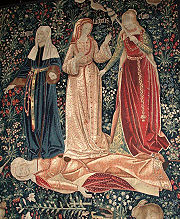
Mille-fleur
Encyclopedia

Motif (art)
In art, a motif is an element of a pattern, an image or part of one, or a theme. A motif may be repeated in a design or composition, often many times, or may just occur once in a work. A motif may be an element in the iconography of a particular subject or type of subject that is seen in other...
in tapestry
Tapestry
Tapestry is a form of textile art, traditionally woven on a vertical loom, however it can also be woven on a floor loom as well. It is composed of two sets of interlaced threads, those running parallel to the length and those parallel to the width ; the warp threads are set up under tension on a...
and other applied art
Applied art
Applied art is the application of design and aesthetics to objects of function and everyday use. Whereas fine arts serve as intellectual stimulation to the viewer or academic sensibilities, the applied arts incorporate design and creative ideals to objects of utility, such as a cup, magazine or...
s and craft
Craft
A craft is a branch of a profession that requires some particular kind of skilled work. In historical sense, particularly as pertinent to the Medieval history and earlier, the term is usually applied towards people occupied in small-scale production of goods.-Development from the past until...
s during the Middle Ages
Middle Ages
The Middle Ages is a periodization of European history from the 5th century to the 15th century. The Middle Ages follows the fall of the Western Roman Empire in 476 and precedes the Early Modern Era. It is the middle period of a three-period division of Western history: Classic, Medieval and Modern...
in Europe
Europe
Europe is, by convention, one of the world's seven continents. Comprising the westernmost peninsula of Eurasia, Europe is generally 'divided' from Asia to its east by the watershed divides of the Ural and Caucasus Mountains, the Ural River, the Caspian and Black Seas, and the waterways connecting...
.
Mille-fleurs style was most popular in late 15th and early 16th century French and Flemish
Flanders
Flanders is the community of the Flemings but also one of the institutions in Belgium, and a geographical region located in parts of present-day Belgium, France and the Netherlands. "Flanders" can also refer to the northern part of Belgium that contains Brussels, Bruges, Ghent and Antwerp...
tapestry
Tapestry
Tapestry is a form of textile art, traditionally woven on a vertical loom, however it can also be woven on a floor loom as well. It is composed of two sets of interlaced threads, those running parallel to the length and those parallel to the width ; the warp threads are set up under tension on a...
, with the best known examples including The Lady and the Unicorn
The Lady and the Unicorn
The Lady and the Unicorn is the modern title given to a series of six tapestries woven in Flanders of wool and silk, from designs drawn in Paris in the late fifteenth century, The suite, on display in the Musée du Moyen-Âge, is often considered one of the greatest works of art of the Middle...
and The Hunt of the Unicorn
The Hunt of the Unicorn
The Hunt of the Unicorn, often referred to as the Unicorn Tapestries, is a series of seven tapestries dating from 1495–1505. The tapestries show a group of noblemen and hunters in pursuit of a unicorn. It is believed the tapestries were made in the Southern Netherlands.-Production:The...
. The term is also used to describe Oriental rugs with a similar design, originally Persian but later produced in much of the Middle East
Middle East
The Middle East is a region that encompasses Western Asia and Northern Africa. It is often used as a synonym for Near East, in opposition to Far East...
and Mughal
Mughal Empire
The Mughal Empire , or Mogul Empire in traditional English usage, was an imperial power from the Indian Subcontinent. The Mughal emperors were descendants of the Timurids...
India – the medieval European style may have been influenced by Persian miniatures or carpets.
See also
- Mille Fleur is a breed of Belgian chicken.
- MillefioriMillefioriMillefiori is a glasswork technique which produces distinctive decorative patterns on glassware.The term millefiori is a combination of the Italian words "mille" and "fiori" . Apsley Pellatt was the first to use the term "millefiori", which appeared in the Oxford Dictionary in 1849...
is the equivalent ItalianItalian languageItalian is a Romance language spoken mainly in Europe: Italy, Switzerland, San Marino, Vatican City, by minorities in Malta, Monaco, Croatia, Slovenia, France, Libya, Eritrea, and Somalia, and by immigrant communities in the Americas and Australia...
term, also used in reference to mosaicMosaicMosaic is the art of creating images with an assemblage of small pieces of colored glass, stone, or other materials. It may be a technique of decorative art, an aspect of interior decoration, or of cultural and spiritual significance as in a cathedral...
and glass artGlass artStudio glass or glass sculpture is the modern use of glass as an artistic medium to produce sculptures or three-dimensional artworks. Specific approaches include working glass at room temperature cold working, stained glass, working glass in a torch flame , glass beadmaking, glass casting, glass...
.

